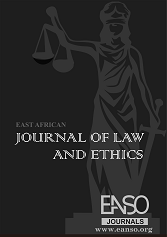Mining Oil and Gas Law: The Geopolitical Vicissitudes of the Extractive Industries
Abstract
The oil and gas industry has been critically acclaimed as one of the most prominent and lucrative business sectors of the 21st century. From a perspicacious viewpoint, the oil and gas sector is lauded for generating revenue, engendering foreign direct investment, and stimulating innovation via state-of-the-art technology. This paper draws emphasis on the fact that resource extraction must comply with the concept of sustainable development through mitigating efforts. Collectively, most of the pungent criticisms that deprecate the prospects of oil and gas mining are commonly reduced to human rights violations and environmental dilapidations. The inauspicious domino effect of the oil and gas industry not only transcends but presents a more alarming challenge as opposed to the immediate human rights and environmental impacts. Geopolitical tensions fueled by national interests have occasioned numerous forms of conflicts at the international level. In what has been termed “the resource-curse,” countries rich in natural resources such as oil and gas are customarily prone to political and economic volatility. The “Dutch-disease,” on the other hand represents a corroboration of the stagnation of other economic sectors as a result of neglect due to overreliance and dependence on oil and gas. The paper further asserts that, at this juncture, international law and relations have been severely predisposed by the oil and gas industry through foreign policy. As a foreign policy tool, oil and gas mining prescribes international alliances and the national interests of key stakeholders. In turn, foreign policy decisions related to oil and gas mining, have led to copious disputes and economic sanctions with geopolitical implications and motivations. This paper posits that in addition to human rights and environmental concerns, there are intrinsic challenges such as the resources-curse and Dutch-disease that form an integral part of the deleterious reputation tainting the oil and gas industry. While acknowledging the benefits, this paper accentuates that the extreme risk and reward aspect necessitates a comprehensive understanding of the multifaceted challenges inherent in the legal framework regulating the oil and gas mining industry
Downloads
References
Claudine Sigam and Loenardo Garcia “Extractive Industries: Optimizing Value Retention in Host Countries,” UNCTAD, New York and Geneva, 2012, page 3. Available at: https://unctad.org/system/files/official- document/suc2012d1_en.pdf
“The mining industry involves the discovery and extraction of naturally occurring minerals from the earth.” Available at: https://www.flyability.com/mining- industry#:~:text=The%20mining%20industry%20accounts%20for,of%20its%20economic%20life%20cycle.
“Forestry is defined as the art and science of managing forestland. It believes that forests can be managed rationally over long periods of time according to explicit objectives. It covers the protection of the forest, the growing of trees, or silviculture, the continuous production of wood and other products under a principle of sustained yield, watershed management, and the maintenance of all the other ecosystem services and values that forests provide to people.” See M. Agnoletti, J. Dargavel & E. Johann “History of Forestry,” Encyclopedia of Life Support Systems (EOLSS), Page 3. Available at: https://www.eolss.net/sample-chapters/c10/E5-01A-02.pdf
“Fish is an excellent source of animal protein and a wide range of essential nutrients contributes significantly to food security… Fisheries and aquaculture, directly or indirectly, play an essential role in the livelihoods of millions of people around the world, from the small-scale inland fishers who harvest fish from lakes and rivers to the men and women who work in large processing plants. See FAO “Fisheries and Aquaculture.” Available at: https://www.fao.org/3/am859e/am859e07.pdf, [A]quaculture broadly refers to the cultivation of aquatic organisms in controlled aquatic environments for any commercial, recreational or public purpose.” Available at: https://www.noaa.gov/stories/what-is- aquaculture#:~:text=The%20term%20aquaculture%20broadly%20refers,commercial%2C%20recreational%20or%20public%20purpose.
“Oil and gas sector comprise three main activities - upstream (exploration and production), midstream, (transportation and processing), and downstream (distribution and sale to end users/consumers).” Emily Darko “Short Guide Summarizing the Oil and Gas Industry lifecycle for a non-technical audience,” Overseas Development Institute, October 2014, page 1. Available at: https://assets.publishing.service.gov.uk/media/57a089efed915d3cfd0004d4/Short_guide_summarising_the_oil_and_gas_industry_lifecycle-43.pdf
“A nonrenewable energy is one that does not renew itself at a sufficient rate for sustainable economic extraction in meaningful human time frames. The non-renewable energy is energy from fossil fuels such as coal, crude oil, natural gas and uranium. Unlike renewable energy, non-renewable energy need human intervention to make it suitable for consumption. Fossil fuels are mainly made up of carbon. It is believed that fossil fuels were formed over 300 million years ago when the earth was different in its landscape.” Page 2. Available at: https://envirsc.uok.edu.in/Files/ab1ac1f1-07e3-42a2- 85bc- 83717ef39155/Menu/Natural_Resources_18301CR_e-tutorial_96110591-89c3-4cd2-9c33-fd14ebb1325a.pdf
“Non-Renewable Source of Energy,” MODULE – 8B, Available at: https://nios.ac.in/media/documents/333courseE/28B.pdf
“The Sustainable Use of Natural Resources: The Governance Challenge,” By Jennifer Bansard, Mika Schroder on April 15, 2021. Available at: https://www.iisd.org/articles/deep-dive/sustainable-use-natural-resources-governance-challenge
See Ting Feng, Ruoyu Xiong and Peng Huan “Productive use of natural resources in Agriculture: The main Policy Lessons,” Resources Policy Volume 85, Part A August 2023, 103793. Available at: https://www.sciencedirect.com/science/article/abs/pii/S0301420723005044
“Sustainability is defined as a requirement of our generation to manage the resource base such that the average quality of life that woe ensure ourselves can potentially be shared by all future generations. The notion 'quality of life' is meant to include everything that influences the situation in which people live. Hence, the notion includes much more than material consumption. Extending the requirement of sustainability to future generations yields the following definition of sustainable development: Development is sustainable if it involves a non-decreasing average quality of life. Furthermore, it places the following requirement on our generation: Our generation's management of the resource base is sustainable if it constitutes the first part of a feasible sustainable development. This is the interpretation of sustainability which has been suggested in a number of references.” Geir B. Asheim “Sustainability: Ethical Foundations and Economic Properties,” The World Bank Policy Research Department, Public Economics Division, Policy Research working Paper 1302, May 1994. Available at: https://documents1.worldbank.org/curated/pt/605011468739497097/pdf/multi0page.pdf
“Importance of Oil and Gas Industry,” available at: https://adiinstitute.co.in/importance-of-oil-and-gas-industry/#:~:text=The%20oil%20and%20gas%20business,as%20the%20world's%20powerhouse%20industry.
“Advantages, Disadvantages, and Economic Benefits Associated with Crude Oil Transportation,” Great Lakes Commission, des Grands Lacs, Issue Brief 02/20/2015. Available at: https://www.glc.org/wp-content/uploads/Oil-Transportation-IssueBrief2-2015.pdf
“Extractive industries recover raw materials from the earth, process them, and turn them into products and services for use by consumers. These raw materials may be fossil fuels (notably coal, oil and gas), minerals (such as bauxite, phosphate, potash, copper, gold and diamonds, rare earth minerals) and aggregates (such as sand, gravel and clay)” “Transforming Extractive Industries for Sustainable Development,” United Nations, May 2021. Footnote 1, page 4. Available at: https://www.un.org/sites/un2.un.org/files/sg_policy_brief_extractives.pdf
See Emil M. Sunley. Thomas Bausgaard, & Dominique Simard “Revenue from the Oil and Gas Sector: Issues and Country Experience,” International Monetary Fund (“IMF”) page 153. Available at: https://www.elibrary.imf.org/display/book/9781589061750/ch006.xml
Moayad H. Al Rasasi, John H. WUalls, & Bander K. Aghamdi “Oil Revenues and Ecnomic Growth in Saudi Arabia,” SAMA Working PapPage 15. Available at: https://www.sama.gov.sa/en- US/EconomicResearch/WorkingPapers/Oil%20Revenues%20and%20Economic%20Growth%20in%20Saudi%20Arabia.pdf , Yousif M. Mohammad Alameen “The Norweigian Oil Eperience of Economic Diversification: A Comparative Study with Gulf Oil, Euopean Journal Of Business Management,” Vol. 8, No. 15, 2016, page 94 Available at: https://core.ac.uk/download/pdf/234627293.pdf
Rabah Arezki, Zoltan Jakab, Douglas Laxton, Akito Matusmoto, Armen Nurbekyan, Hou Wang, & Jiaxiong Yao, “Oil Prices and the Global Economy,” IMF Working Paper, January (2017), page 5. Available at:
Mohsin Dhali, Shafiqul Hassan & Umashankar Subramanim “Comparative Analysis of Oil and Gas Legal Frameworks in Bangladesh and Nigeria: A pathway towards Achieving Sustainable Energy through Policy,” Sustainability 2023, page 1-2. Available at: https://www.mdpi.com/2071-1050/15/21/15228
“GDP measures the monetary value of final goods and services—that is, those that are bought by the final user—produced in a country in a given period of time (say a quarter or a year). It counts all the output generated within the borders of a country. GDP is composed of goods and services produced for sale in the market and also includes some nonmarket production, such as defense or education services provided by the government. An alternative concept, gross national product, or GNP, counts all the output of the residents of a country.” See Tim Callen “What is Gross Domestic Product?” Finance & Development, December 2008, page 48. Available at: https://www.imf.org/external/Pubs/FT/fandd/2008/12/pdf/basics.pdf
Stevens Paul “The role of oil and gas in the Development of the Global Economy,” WIDER Working Paper, No. 2016/175, Provided in Cooperation with: United Nations University (UNU), World Institute for Development Economics research (WIDER) Page 5.
Johannes Hirata “The Power of GDP and its Limitation,” Chapter 16, page 381. Available at: https://www.bhutanstudies.org.bt/publicationFiles/OccasionalPublications/Transforming%20Happiness/Chapter%2016%20The%20Power%20of%20GDP%20and%20its%20Limitations.pdf
Ibid.
“As a long literature has emphasized, GDP as conventionally defined differs in many ways from welfare. The economists who developed the modern concept of GDP were well aware of this distinction. For example, in a 1934 report to Congress, Kuznets states that “the welfare of a nation… can scarcely be inferred from a measure of national income” (Bureau of Foreign and Domestic Commerce and Kuznets, 1934).” Karen Dynan “GDP as Measure of Economic Well-being,” Hutchins Center Working paper #43, August 2018, page 5. Available at: https://www.brookings.edu/wp-content/uploads/2018/08/WP43-8.23.18.pdf
Johannes Hirata supra note 20 at 381.
Praew Grittayaphong “Beyond GDP: Three Other Ways to Measure Economic Health,” April 19. 2023. Available at: https://www.stlouisfed.org/open-vault/2023/apr/three-other-ways-to-measure-economic-health-beyond-gdp
“The HDI is a summary measure for assessing long-term progress in three basic dimensions of human development: long and healthy life, access to knowledge and a decent standard of living.” UNDP “Human Development Data,” 2024. Available at: https://hdr.undp.org/data-center
Praew Grittayaphong supra note 24.
Cecilia Adrogue & Ricardo Crespo “Implicit Assumptions when Measuring in Economics: The Human Development Index (HDI) as a Case Study,” Revista Cultura Economica, Ano XXVII. No 79, December 2010, 33-42, Page 36.
M. Awaludin, Muhammad Asdar, Rusnaedi, Hasnah Bolkiah, Novi Firman, Erviandy Samir, “Local Governemtn Policies in Increasing the Human Development Index in Bone District,” Journal Office: Journal Pemikiran Ilmiah dan Pendidikan Adminisrasi Perkantroan. Vol. 7, Number 1. January-June 2021, 145-158, page 147.
Hans-Holger Rogner & Anca Popescu “An Introduction to Energy,” Chapter 1, Energy and Major Global Issues,” PART 1, Page 34. Available at: https://www.undp.org/sites/g/files/zskgke326/files/publications/chapter1.pdf
“Energy,” The World Bank, IBRD – IDA, available at: https://www.worldbank.org/en/topic/energy/overview
Jayant Sathaye & Alan H. Sanstad “Bottom-Up Energy Modeling,” Encyclopedia of Energy, 2004. Available at: https://www.sciencedirect.com/topics/social- sciences/energy- sector#:~:text=The%20energy%20sector%20comprises%20the,and%20delivery%20of%20energy%20products).
Ibid.
Kevin Bertelsen & Matt Sedlacek “Energy Sector Overview,” February 18, 2014, page 1. Available at: https://s3.wp.wsu.edu/uploads/sites/606/2015/02/SectorOverview_ENE_Spring2014.pdf
Obadia Kyetuza Bishoge, Lingling Zhang, Witness Gerald Mushi, Shaldon Leparan Suntu, “The Overview of the Legal and Institutional Framework for Oil and Gas Sector in Tanzania – A review,” Journal of Applied and Advanced Research (2018) page 8. Available at: https://updatepublishing.com/journal/index.php/jaar/article/view/6749/pdf
Ibid. at 16
James Coleman “The Third Age of Oil and Gas Law,” Indiana Law Journal, Volume 95, Issue 2 (2020), page 390. Available at: https://www.repository.law.indiana.edu/cgi/viewcontent.cgi?article=11369&context=ilj
Reem Abuiyada “Traditional Development Theories have failed to Address the Needs of the majority of People at Grassroots Levels with Reference to GAD,” International journal of Business and Social Science Vol. 9. No. 9 of September 2018, page 115. Available at: https://ijbssnet.com/journals/Vol_9_No_9_September_2018/12.pdf
“Development has often been confused with “economic growth as measured solely in terms of annual increases in pre-capita income or gross national product, regardless of its distribution and the degree of people’s participation in effective growth.” Ibid.
Irma Adelman “Fifty Years of Economic Development: What Have we Learned?” Page 1. Available at: https://documents1.worldbank.org/curated/en/625131468761704307/pdf/28737.pdf
Ibid. 95
Sen “The Concept of Development,” Handbook of Development and Economics, Volume I. Elsevier Science Publishers B.V., 1998 page 20. Available at: http://ivut.iut.ac.ir/content/300/5915.THE_CONCEPT_OF_DEVELOPMENT.pdf
Sen, A. (1999). Development as freedom. Oxford University Press. Introduction, page 1. Available at: http://www.c3l.uni-oldenburg.de/cde/OMDE625/Sen/Sen-intro.pdf
Yaasmin Farzan Abdul Karim, Sharifah Nazura Syed-Noh, & Noor Azila Mohd Zaid “Financial Risk and Leverage Relationship of Oil and Gas Local Companies in Malysia,” International Journal of Business, Economics and Law, Vol 14, Issue 1, December 2017, page 13. Available at: https://ijbel.com/wp-content/uploads/2018/01/ACC-43.pdf
“Foreign direct investment is a category of cross-border investment associated with a resident in one economy having control or a significant degree of influence on the management of an enterprise that is resident in another economy. As well as the equity that gives rise to control or influence, direct investment also includes investment associated with that relationship, including investment in indirectly influenced or controlled enterprises, investment in fellow enterprises (enterprises controlled by the same direct investor), debt (except selected debt), and reverse investment.” The World Bank, IBRD – IDA, “What is the Difference between Foreign Direct Investment (FDI) net inflows and net outflows?, available at: https://datahelpdesk.worldbank.org/knowledgebase/articles/114954-what-is-the-difference-between-foreign-direct-inve
“Capital intensive industries are those industries that require large sums of money to operate effectively.” See Yaasmin Farzan supra note 43 at 13.
Ibid.
“The Future of Work in the Oil and Gas Industry,” International Labor Organization, Technical meeting on the future of work in the oil and gas industry (Geneva, 28 November – 2 December 2022), page 6. Available at: https://www.ilo.org/wcmsp5/groups/public/---ed_dialogue/---sector/documents/publication/wcms_859846.pdf
“Being the world’s most valuable commodities, oil and gas have greatly contributed to the wealth and power of governments and corporations that are endowed with these natural resources and that control their production and distribution. For this reason, the desire and ability to control oil and gas have played a significant role in geopolitics, wars and conflicts across the globe, and continue to do so today.” For more see: “The Future of Work in the Oil and Gas Industry,” International Labor Organization, Technical meeting on the future of work in the oil and gas industry (Geneva, 28 November – 2 December 2022), page 6. Available at: https://www.ilo.org/wcmsp5/groups/public/---ed_dialogue/- - - sector/documents/publication/wcms_859846.pdf
International Labor Organization “Oil and gas production.” Available at: https://www.ilo.org/inform/online-information-resources/research-guides/economic-and-social-sectors/energy-mining/oil-gas-production/lang--en/index.htm#:~:text=The%20ILO%20estimates%20that%20nearly,from%20a%20very%20low%20base.
See Benjamin J. Parsalaw “The Esoteric Nature of Bilateral Investment Treaties: Transnational Corporations and Human Rights,” Tuma Law Review, Volume 7, Issue 1, July 2021, page 6. See also: Saud M. Al-Fattah “National Oil Companies: Busines Models, Challenges, and Emerging Trends,” Corporate Ownership & Control, Volume 11, Issue 1, 2013, page 713. Available at: https://www.virtusinterpress.org/IMG/pdf/10-22495cocv11i1c8art2.pdf
Mostafe Elsan & Mehdi Yousefi Cheherghani “Legal Aspects of Technology Transfer Through Foreign Investment in Oil and Gas Industry,” Petroleum Business Review, Volume 3, Issue 2, June 2019, page 55. Available at: https://www.google.com/search?q=technology+transfer+in+oil+and+gas+via+fdi&oq=technology+transfer+in+oil+and+gas+via+fdi&gs_lcrp=EgZjaHJvbWUyBggAEEUYOTIHCAEQIRigATIHCAIQIRigATIHCAMQIRigAdIBCDc2NTJqMGo5qAIAsAIB&sourceid=chrome&ie=UTF-8#:~:text=Legal%20Aspects%20of,ac.ir%20%E2%80%BA%20...
African Development Bank and the African Union “Oil and Gas in Africa,” July 29, 2009, page 34-35. Available at: https://www.afdb.org/fileadmin/uploads/afdb/Documents/Publications/Oil%20and%20Gas%20in%20Africa.pdf
J.L. Simbakila “Challenges Ahead for Tanzania to Build New Capacities for Gas Industry Development,” ESRF Discussion Paper No.51, page 9. Available at: https://esrf.or.tz/wp-content/uploads/2021/05/Discussion051.pdf
Emil M. Sunley supra note 153.
Min Xu, Tianzhi Chen, Zhiyao Jiang, Kaiyang Qu, Yafei Cui “The Impact of Government Budget on Social Development and Optimization Strategy,” Frontiers in Humanities and Social Science, Volume 4, Issue 6. 2024, page 359.
Gole Lalude “Importance of Oil to the Global Community,” Global journal of Human-Social Science, Volume 15 Issue 1 Version 1.0 Year 2015, page 2.
Ibid.
Ibid. at page 3.
“Searching for underground or underwater crude oil and natural gas fields by drilling and operating the wells that recover and bring the crude oil and raw natural gas to the surface. Upstream exploration and production can occur onshore or offshore. Shales gas oil exploration are nowadays very active part of this sector.” Petroleum Oil and Gas Downstream, Application Note. Page 1. Available at: https://prodetec.com.au/wp- content/uploads/2020/08/pog_downstream_application_note_a4_en_gf30046e- en_application_note_pog_downstream_finala4-98282.pdf
“The transportation (pipeline, rail, barrage, oil tanker or truck) and storage of oil and gas from well to the refiner or natural gas processing plant.” Ibid.
The refining of crude oil and the processing and purifying of raw natural gas that produces petroleum products such as gasoline, diesel fuel, base for asphalt, heating oil, kerosene, and liquified petroleum gas (LPG). Often integrated in the downstream market are petrochemical plants that utilize the petroleum and gas products to produce Ethylene, Propylene, Benzene, Butadiene, and other by products used by multiple types of industries.” Ibid.
Harvard Devold “Oil and gas production handbook: An introduction to oil and gas production, transport, refining and petrochemical industry.” Page 4. Available at: https://library.e.abb.com/public/34d5b70e18f7d6c8c1257be500438ac3/Oil%20and%20gas%20production%20handbook%20ed3x0_web.pdf
J. Craig and F. Quagiliaroli “The oil and Gas Upstream Cycle: Exploration Activity,” Via Emilia 1, 20097 San Donato Milanese (MI), Italy, page 2. Available at: https://www.epj- conferences.org/articles/epjconf/pdf/2020/22/epjconf_lnes2020_00008.pdf
Exposure Draft – March 2022, page 108. Available at: https://www.ifrs.org/content/dam/ifrs/project/climate-related-disclosures/industry/extractives-and-minerals-processing/issb-exposure-draft-2022-2-b12-oil-and-gas-midstream.pdf
“Some companies, such as ExxonMobil, Shell, and BP, perform activities in each of these segments. However, many of the thousands of firms in the oil and gas industry are specialists or niche players; further, some carry out different activities within one or more of the above segments.” Peter D Cameron and Michael C. Stanley “Oil and Gas, and Mining: A Sourcebook for Understanding the Extractive Industries,” Chapter 3: The Extractive Industries, page 49. Available at: https://documents1.worldbank.org/curated/en/222451496911224999/pdf/Oil-Gas-and-Mining-A-Sourcebook-for-Understanding-the-Extractive-Industries.pdf
Han Zhang, Qingashn Feng, Bingchuan Yan, Xianbin Zheng, Yue Yang, Jian Chen, Hong Zhang and Xiaoben Liu “State of the Art of Oil and Gas Pipeline Vulnerability Assessment,” Energies 2023, 16, 3439, page 1. Available at: file:///Users/Parsalaw/Downloads/energies-16-03439-v2.pdf
“Emerging Oil and Gas Technologies,” Texas Methane and Flaring Coalition,” page 1. Available at: https://docs.txoga.org/files/1965-emerging-oil-natural-gas-technologies-.pdf
John David Anderson “A History of Aerodynamics: And its Impact on Flying Machines,” Cambridge University Press 1977, page 4-5. (available at: https://books.google.co.tz/books?id=1OeCJFJY3ZYC&pg=PA4&redir_esc=y#v=snippet&q=state-of-the-art&f=false )
Henry Harrison Suplee “The Gas Turbine: Progress in the Design and Construction of Turbines operated by gases of Combustion,” Philadelphia: J.B. Lippincott, 1910. Available at: https://archive.org/details/gasturbineprogre00suplrich/page/6/mode/2up
Ibid.
Ibid.
John David Anderson “A History of Aerodynamics: And its Impact on Flying Machines,” Cambridge University Press 1977, page 4-5. (available at: https://books.google.co.tz/books?id=1OeCJFJY3ZYC&pg=PA4&redir_esc=y#v=snippet&q=state-of-the-art&f=false )
“[While] One practitioner has noted that the term has really never been defined in any judicial decision…. However, to the term as “general, commonly used phrase whose meaning may include industry custom or the most scientifically advanced developments in the field,”… The Iowa Supreme Court has stressed the distinction between “state of the art,” which it viewed as “defense to a design defect claim,” and “custom and practice,” which it stressed is not the same as state of the art.” “Shapo on the Law of Product Liability,” Page 10- 3 – 1- 4, Available at: https://www.google.co.tz/books/edition/Shapo_on_the_Law_of_Products_Liability/UTOmOvepHPEC?hl=sw&gbpv=1&dq=state+of+the+art+meaming&pg=SA10-PA4&printsec=frontcover )
“Over the past decade the ‘green economy’ has emerged as a major new buzzword in sustainability discourses and national development strategies globally. The United Nations’ (UN) vision document, The Future We Want, describes the green economy as an economic development model that results in improved human well-being and social equity while significantly reducing environmental risks and ecological scarcities (UN, 2012). In the words of one UN expert panel, it represents nothing short of a “new economic growth paradigm” for moving from an economic system “that allowed, and at times generated crises towards a system that proactively addresses and prevents them.” Ian Bailey and Federico Caprotti “The green economy: functional domains and theoretical directions of Enquiry,” page 1. Available at: https://core.ac.uk/download/pdf/74389601.pdf
“Rio Plus 20,” OHCHR’s Key Messages, page 1. Available at: https://www.ohchr.org/sites/default/files/Documents/Events/Rio20/Rio+20OHCHRPositions20.pdf
Benjamin J. Parsalaw “Uranium Mining in Tanzania: A Stairway to Prosperity or Impoverishment?” 1 JTLS, The Tanzanian Lawyer Journal (2016), page 76-78. Available at: https://tanzlii.org/akn/tz/doc/journal/2016-07-01/the-tanzania-lawyer-vol-1-2016-number-2/eng@2016-07-01, See also: Alii Asghar Sadeghi Mojard, Vahid Atashbari, and Adrian Tantu “Challenges for Sustainable Development Strategies in Oil and Gas Industries,” DOI: 102478/picbe- 2018-0056, page 628. Available at: https://intapi.sciendo.com/pdf/10.2478/picbe-2018-0056
Ibid. at 636
See IPIECA, IFC, UNDP, “Mapping The Oil and Gas Industry to the Sustainable Development Goals: An Atlas,” page 1. Available at: https://www.undp.org/sites/g/files/zskgke326/files/publications/Mapping_OG_to_SDG_Atlas_Executive_Summary_2017.pdf
Ibid at. 1-2
Ali Asghar Sadeghi Mojard, Vahid Atashbari, & Adrian Tantau “Challenges for Sustainable Development Strategies in Oil and Gas,” DE GRUTYER Open, page 629. Available at: https://intapi.sciendo.com/pdf/10.2478/picbe-2018-0056
“Held in Rio de Janeiro, Brazil, from 3-14 June 1992. This global conference, held on the occasion of the 20th anniversary of the first Human Environment Conference in Stockholm, Sweden, in 1972, brought together political leaders, diplomats, scientists, representatives of the media and non-governmental organizations (NGOs) from 179 countries for a massive effort to focus on the impact of human socio-economic activities on the environment.” Available at: https://www.un.org/en/conferences/environment/rio1992
Michael Decleris “The Law of Sustainable Development: General Principles,” A report produced for the European Commission (2000), page 17. Available at: https://www.pik-potsdam.de/avec/peyresq2003/talks/0917/sillence/background_literature/sustlaw.pdf
Ibid. at 11.
Agenda 21 is a comprehensive plan of action to be taken globally, nationally and locally by organizations of the United Nations System, Governments, and Major Groups in every area in which human impacts on the environment.
Agenda 21, the Rio Declaration on Environment and Development, and the Statement of principles for the Sustainable Management of Forests were adopted by more than 178 Governments at the United Nations Conference on Environment and Development (UNCED) held in Rio de Janerio, Brazil, 3 to 14 June 1992. Available at: https://www.un.org/esa/dsd/agenda21/
United Nations Sustainable Development, UNCED, Rio de Janerio, Brazil, 3 to 14 June 1992, AGENDA 21. Available at: https://sustainabledevelopment.un.org/content/documents/Agenda21.pdf?_gl=1*x5lnuk*_ga*MTQxMjIzNzkyMC4xNzE5OTE1NTEy*_ga_TK9BQL5X7Z*MTcyMzAzMTQ0Ni4zLjAuMTcyMzAzMTQ0Ni4wLjAuMA..
“'Geopolitics' means the struggle between rival powers for control over territory or natural resources like oil and gas, minerals, food products, water, etc., vital geographic features, such as strategic harbors and military base locations, rivers and canals, trade routes, etc, and other sources of economic and military advantage. The term ‘Geopolitics’ was coined in 1899 by the Swedish political scientist Rudolf Kjelln and then geopolitics emerged as a systematic area of study. Capitalism created a world market going across boundaries, but at the same time it is based on ruthless competition between rival countries. This struggle to achieve market shares has always been dominated by successive superpowers.” Anshuman Gupta & Surbhi Arora “Control Oil – Rule the World,” page 4.
“The Geopolitics of Oil and Gas,” KPMG 2023, page 2. Available at: https://assets.kpmg.com/content/dam/kpmg/au/pdf/2023/geopolitics-of-oil-and-gas.pdf
Ibid.
Ibid. at page 4.
“Natural Resources, Conflict, and Conflict Resolution,” United States Institute of Peace, Washington, DC. page 4. Available at: https://www.usip.org/sites/default/files/file/08sg.pdf
Ibid.
Ian Bannon & Paul Collier “Natural Resources and Violent Conflict,” The World bank, Washington, D.C, 2003, page 164. Available at: https://documents1.worldbank.org/curated/es/578321468762592831/pdf/282450Natural0resources0violent0conflict.pdf
Ibid.
“Are societies with abundant resources cursed? The “paradox of plenty” refers to the observation that many societies with abundant natural resources have worse economic outcomes than those that lack natural resources. Typically, this paradox is attributed to abundant resources crowding out activities that improve economic outcomes.” Andreas Leibbrandt & John Lynham “Does the Paradox of Plenty Exist” experimental Evidence on the Curse of Resource Abundance,” Monash Business School, Department of Economics, ISSN 1441-5429, Discussion Paper 03/17, page 2. Available at: https://www.monash.edu/business/economics/research/publications/publications2/0317paradoxleibbrandtlynham.pdf
“The Resource Curse: The political and Economic challenges of Natural Resource Wealth,” NRGI Reader, March 2015, page 1. Available at: https://resourcegovernance.org/sites/default/files/nrgi_Resource-Curse.pdf
Ibid. page 1-3.
“Political scientists point to examples of the Democratic Republic of the Congo, the Niger Delta, Iraq, Libya and Angola to illustrate this tendency. Petro-aggression, the tendency of oil-rich states to instigate or be targets of international conflict, has been observed in some cases, such as with Iraq’s invasion of Iran and Kuwait, but researchers debate whether the data supports the conclusion that resource-rich countries do this at a greater rate than non-resource-rich countries.” Ibid.at page 2.
Ibid. page 5.
Cite as: 569 U. S. ____ (2013) SUPREME COURT OF THE UNITED STATES No. 10–1491. Available at: https://supreme.justia.com/cases/federal/us/569/10-1491/case.pdf
Ibid. page 2.
Ibid.
“In the late 1950s the appreciation of the Dutch currency (guilder), which followed the gas export boom, caused inflation which in turn, brought about reductions in competitiveness and profitability of the manufacturing service sector…. The Dutch exports crashed down relative to GDP during the 1960s onwards, the Dutch exports of non-gas industries have increased sensibly. The fear of de-industrialization linked to the Dutch disease did not materialize in the Netherlands.” International Competitiveness of the Russian Federation, page 1. Available at: http://www.ecostat.unical.it/Algieri/Didattica/Economia%20Internazionale/materiale%20x%20internazionale/THE%20DUTCH%20DISEASEa.pdf
Ibid.
Ibid.
NRGI supra note 95
Kareem Ismail “The structural Manifestation of the “Dutch Disease: The case of Oil Exporting Countries,” IMF Working Paper, Strategy, Policy, and Review Department (2010), page 4. Available at: https://www.imf.org/external/pubs/ft/wp/2010/wp10103.pdf
Ibid.
Ibid.
Titus Utibe Monday & Muhammed Salihu “Crude Oil and the Politics of Nigerian Foreign Policy Issues and Explanation,” Research on Humanities and Social Sciences, Vol. 7, No. 7. 2017, page 38. Available at: https://core.ac.uk/download/pdf/234675931.pdf
Sait Sonmez & Sedat Cobanoglu “The Use of Energy resources as Foreign Policy Tools: The Russian Case,” European Scientific Journal April 2016, edition Vol. 12, page 81. Available at: https://core.ac.uk/download/pdf/236410673.pdf
“Modern concepts of national security arose in the 17th century during the Thirty Years War in Europe and the Civil War in England. In 1648, the Peace of Westphalia established the idea that the nation state had sovereign control not only of domestic affairs such as religion, but also of external security. The idea of the nation-state is commonplace today, yet it would be wrong to assume that it is the only way to look at international security. The pre Westphalia international system was based on the assumption that there existed a universal principle governing the affairs of states led by emperors, popes, kings, and princes. That was indeed the principle of the Holy Roman Empire. The new idea of the nation state took a different approach. Peace and stability could be better served if people were not slaughtering each other over some universal principle—in that case, religion. It would be far better to have an international system based on the equilibrium of nation states dedicated to the limited purposes of national sovereignty and self-defense.” See Kim R. Holmes “What is National Security,” The Heritage Foundation, 2015 Index of U.S. Military Strength, page 17. Available at: https://www.heritage.org/sites/default/files/2019- 10/2015_IndexOfUSMilitaryStrength_What%20Is%20National%20Security.pdf
Ibid at 23.
Jefrey P. Bialos “Oil Imports and National security: The Legal and Policy Framework for Ensuring Untied States Access to Strategic Resources,” Published by Penn Carey Law: Legal scholarship Repository, 2014, page 236. Available at: https://scholarship.law.upenn.edu/cgi/viewcontent.cgi?referer=&httpsredir=1&article=1591&context=jil
Keith Crane, Andreas Goldthau, Michael Toman, Thomas Light, Stuart E. Johnson Alireza Nader, Angel Rabas & Harun Dogo “Oil as a Foreign Policy Instrument,” Imported Oil and U.S. National Security, page 25. Available at: https://www.jstor.org/stable/pdf/10.7249/mg838uscc.11.pdf?refreqid=fastly- default%3A38d60875f948877fb99b4410f4744f34&ab_segments=&origin=&initiator=&acceptTC=1
“Foreign Policy and National Security Implications of Oil Dependence,” Committee on Foreign Affairs, House of Representatives, first session, March 22, 2007, Serial No.110-33, page 3. Available at: https://www.govinfo.gov/content/pkg/CHRG-110hhrg34241/pdf/CHRG-110hhrg34241.pdf
“A number of countries have embargoed the export of oil to countries with which they are at odds. South Africa faced an almost universal official embargo on oil, although it never had problems arranging oil imports through third parties. Most Arab states continue to embargo exports of oil to Israel. Consuming nations have embargoed oil imports: The United States, for example, refuses to purchase oil from Iran. These embargoes have been adopted to pressure foreign governments to change policies, such as apartheid in South Africa, or, in some instances, to precipitate a change in government. In this section, we review the successes and failures of oil embargoes to influence foreign policy decisions by consuming nations.” For more see: Keith Crane, Andreas Goldthau, Michael Toman, Thomas Light, Stuart E. Johnson Alireza Nader, Angel Rabas & Harun Dogo “Oil as a Foreign Policy Instrument,” Imported Oil and U.S. National Security, page 25. Available at: https://www.jstor.org/stable/pdf/10.7249/mg838uscc.11.pdf?refreqid=fastly-default%3A38d60875f948877fb99b4410f4744f34&ab_segments=&origin=&initiator=&acceptTC=1
See Kim R. Holmes “What is National Security,” The Heritage Foundation, 2015 Index of U.S. Military Strength, page 22. Available at: https://www.heritage.org/sites/default/files/2019-10/2015_IndexOfUSMilitaryStrength_What%20Is%20National%20Security.pdf
“These targeted sanctions included arms embargoes, financial sanctions on the assets of individuals and companies, travel restrictions on the leaders of a sanctioned state, and trade sanctions on particular goods.” For more see: Jon Gordon “Smart Sanctions Revisited,” Ethics and International Affairs, Vol. 25, No3, Fall (2011), page 315. Available at: https://www.cambridge.org/core/journals/ethics-and-international-affairs/article/smart-sanctions-revisited/14E85413C04EE483370E6A23CB7C7225
Ibid.
“Being the world’s most valuable commodities, oil and gas have greatly contributed to the wealth and power of governments and corporations that are endowed with these natural resources and that control their production and distribution. For this reason, the desire and ability to control oil and gas have played a significant role in geopolitics, wars and conflicts across the globe, and continue to do so today.” For more see: “The Future of Work in the Oil and Gas Industry,” International Labor Organization, Technical meeting on the future of work in the oil and gas industry (Geneva, 28 November – 2 December 2022), page 6. Available at: https://www.ilo.org/wcmsp5/groups/public/---ed_dialogue/---sector/documents/publication/wcms_859846.pdf
Copyright (c) 2024 Benjamin J. Parsalaw

This work is licensed under a Creative Commons Attribution 4.0 International License.




























